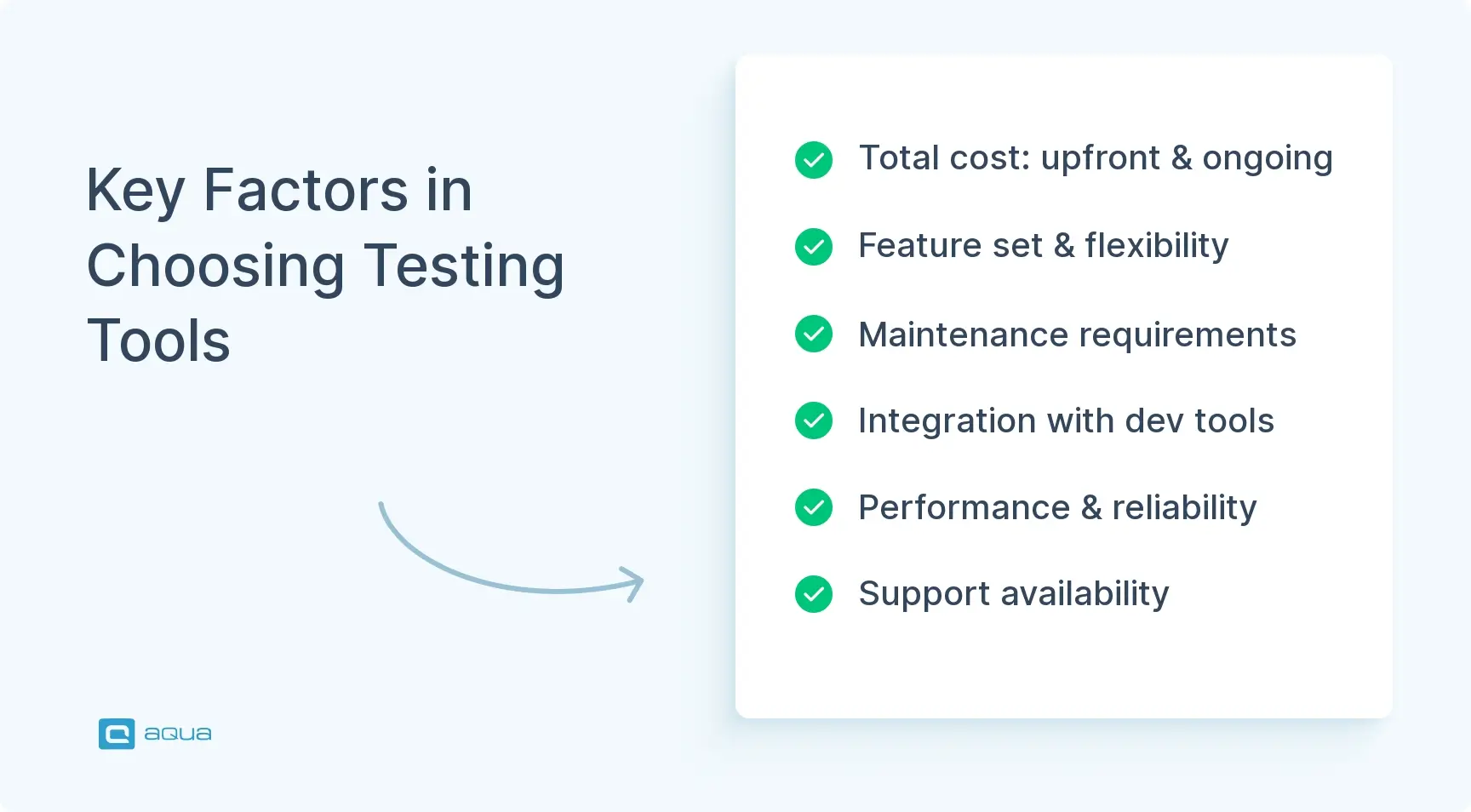What is an Open-Source Testing Tool?
An open-source testing tool is software whose source code is freely available to the public. Anyone can view, modify, and distribute the code under licenses that maintain these freedoms.
Think of open source testing tools as community-built solutions where developers worldwide collaborate to create and improve the software. This approach often leads to robust tools with active user communities and extensive documentation.
The rise of open-source test automation has changed how teams approach quality assurance as they provide flexible frameworks that can be adapted to various testing scenarios. Open-source tools for testing applications offer tremendous value, particularly for teams with specific requirements or budget constraints.
Popular examples include:
- Selenium – The go-to framework for browser automation testing
- JMeter – A powerful tool for performance and load testing
- Cypress – A newer JavaScript-based end-to-end testing framework
- Appium – For mobile application testing across platforms
- Robot Framework – A generic test automation framework
These open-source software testing tools have gained massive popularity due to their zero license cost and the flexibility to adapt them to specific testing needs. According to a BrowserStack survey, over 60% of QA teams use at least one open source tool in their testing stack.
OpenSource? As other user pointed out, usually choices are awful, and you need to deploy and support it. Are you willing to extend and configure deployed open source in the future, to integrate with API / external CI? So yeah, agile, but any QA will tell you what you will need 2 years from now, and bad choice now, will just bring cost and delay in the future.
What is a Commercial (Paid) Testing Tool?
Commercial testing tools are the software solutions developed and sold by companies that specialise in testing technologies. Unlike their open source counterparts, these tools require licensing fees or subscription payments for use.
Commercial testing tools are designed with enterprise needs in mind. They often come as complete packages with comprehensive features, professional support, and regular updates managed by dedicated development teams.
When considering a paid testing tool, you often expect enhanced reliability and streamlined workflows compared to open-source alternatives. A commercial testing tool typically offers more polished integration points and dedicated customer success teams.
A prime example of a commercial testing tool is aqua cloud. Designed with enterprises in mind, aqua streamlines your testing efforts through the power of AI. With aqua, you can cut 42% of the time spent on test planning & design stages. A 100% centralised repository allows you to combine manual and automated tests together easily. Automation (open-source) integrations like Selenium, Jenkins, Ranorex allow you to optimise your CI/CD pipelines, while project management/DevOps integrations like Jira and Azure DevOps help you combine the best of both worlds. One-click native bug-recording integration Capture allows you to eliminate the communication barriers between devs and testers, while an AI assistant answers all your questions & concerns regarding test management & platform.
Get 200% efficiency in your testing efforts for every penny you spend
As mentioned, paid solutions aim to provide polished user interfaces, seamless integrations, and out-of-the-box functionality that requires minimal setup. The pricing models vary widely – from a few dollars per user per month to enterprise licenses costing thousands.
Go for aqua cloud and check it yourself. Modern, fast, great solution for teams of all sizes including startups
What Factors to Pay Attention For When Choosing Open-Source or Commercial Testing Software
Selecting the right testing tool involves weighing multiple considerations beyond just the price tag. Let’s examine the key factors that should influence your decision.

Cost
Money talks and it’s often the first thing teams consider when evaluating testing tools. But the true cost picture goes deeper than the sticker price.
| Open Source Tools | Commercial Tools |
|---|---|
| • No licensing fees | • Subscription or perpetual license costs |
| • Free to download and use | • Often priced per user/month or annual contracts |
| • Hidden costs: training, maintenance, infrastructure | • Predictable budgeting with fixed costs |
| • Development resources needed for customization | • ROI through time savings and efficiency |
| • Community support is free but variable in quality | • Support costs usually included in pricing |
| • May require additional tools to fill functionality gaps | • All-in-one solutions reduce tool sprawl costs |
Meanwhile, commercial tools might seem expensive initially, but their all-in-one nature can reduce overall spending on multiple point solutions.
Features and Customisation
The feature set and flexibility of your testing tool directly impact your team’s capabilities and efficiency.
| Open Source Tools | Commercial Tools |
|---|---|
| Highly customisable with access to source code | Comprehensive out-of-the-box functionality |
| Freedom to modify for specific needs | Regular vendor-driven feature updates |
| Feature depth varies widely between tools | Often include advanced reporting and analytics |
| May require integrating multiple tools for full coverage | Purpose-built features for specific testing types |
| New capabilities require coding or community plugins | Limited customisation beyond configuration options |
| Feature updates depend on community activity | Vendor roadmaps determine future capabilities |
In contrast, commercial tools like aqua cloud offer ready-made features like requirements traceability, test case management, and executive dashboards without requiring development work. These pre-built capabilities can accelerate implementation and standardise processes across teams.
The right choice depends on your team’s technical capabilities and specific testing needs. Teams with strong development skills often prefer the flexibility of open source, while those seeking turnkey solutions may find commercial tools more efficient.
Maintenance of the Test Automation Tool
The long-term viability of your testing tool depends on how well it’s maintained and supported over time.
| Open Source Tools | Commercial Tools |
|---|---|
| • Community-driven updates and fixes | • Vendor-guaranteed maintenance |
| • Potential for abandoned projects | • SLAs for bug fixes and updates |
| • Self-managed version control | • Automatic updates with new features |
| • Dependent on volunteer contributors | • Dedicated development teams |
| • Need to track security vulnerabilities | • Vendor manages security patches |
| • Requires in-house expertise to maintain | • Maintenance included in subscription costs |
According to QA professionals surveyed by RadView, maintenance concerns rank among the top three challenges with open source testing tools, with 60% of teams reporting difficulty maintaining their Selenium scripts due to limited coding expertise.
Integrations
Modern testing doesn’t happen in isolation. Your testing tools need to work seamlessly with your broader development ecosystem.
| Open Source Tools | Commercial Tools |
|---|---|
| • Community-developed integrations | • Official integrations with major platforms |
| • API access for custom integrations | • Pre-built connectors for popular tools |
| • Variable documentation quality | • Documented integration pathways |
| • May require coding for integration | • Point-and-click integration configuration |
| • Flexibility to connect with any system | • Partners with other commercial tools |
| • Can be adapted to legacy systems | • Primarily support modern development stacks |
Open source tools typically offer APIs that allow connection to virtually any system, but often require development work to implement. For example, Selenium can integrate with virtually any CI/CD pipeline, but requires custom code to report results back to test management systems.Commercial tools like aqua cloud offer CLI support for no-code integration with Selenium/Cypress, streamlining CI/CD pipelines. They typically provide turnkey integrations with popular development tools like Jira, GitHub, and Azure DevOps, allowing for seamless information flow between systems.
The integration approach you need depends on your existing toolchain and team capabilities. Companies with standardised tool stacks often benefit from commercial solutions with ready-made integrations, while those with unique or legacy systems may need the flexibility of open source.
Performance and Reliability
The performance and reliability of your testing tools directly impact your testing efficiency and results accuracy.
| Open Source Tools | Commercial Tools |
|---|---|
| • Variable performance based on implementation | • Optimised for specific testing scenarios |
| • May require tuning for large-scale use | • Designed for enterprise-scale performance |
| • Reliability depends on implementation quality | • Vendor-guaranteed uptime and reliability |
| • Can be optimised for specific hardware | • Consistent performance across environments |
| • May struggle with complex applications | • Built to handle sophisticated test scenarios |
| • Performance issues addressed by community | • Performance SLAs and guarantees |
Performance considerations vary by testing type. For load testing, open-source JMeter is widely used but can struggle with dynamic web apps requiring real-browser interaction. According to LoadFocus, JMeter users often need to set up distributed testing environments to handle large-scale performance testing.
Commercial tools typically offer more consistent performance. Tools like aqua cloud are designed to maintain reliability even when used for extensive regression test suites. They often include performance optimisation features like parallel test execution and resource allocation controls.
Reliability also extends to test results. Open source tools may produce inconsistent results (especially in UI testing) if not properly configured, while commercial tools typically include built-in stability features like automatic waits and retries for flaky tests.
Support Comparison
When issues arise, the quality and availability of support can make the difference between a quick resolution and prolonged downtime.
| Open Source Tools | Commercial Tools |
|---|---|
| • Community forums and documentation | • Dedicated support teams and customer success |
| • GitHub issues and discussions | • Guaranteed response times |
| • Variable response times | • Live chat/phone support options |
| • Stack Overflow and other public forums | • Training and onboarding services |
| • No guaranteed assistance | • Customer success managers |
| • Learning resources created by community | • Official training certification programs |
Support quality varies dramatically between the two approaches. With open source tools, you’re primarily relying on community goodwill. While active communities like Selenium’s offer extensive documentation and forum support, response times can be unpredictable, and complex issues may go unresolved.
Commercial tools like aqua cloud provide structured support with guaranteed response times through multiple channels (within 8 hours business time in this specific case). They typically offer onboarding assistance, regular check-ins, and even dedicated customer success manager for every customer. This professional support infrastructure can significantly reduce downtime when issues occur.
Support speed and reliability are just one of aqua’s superpowers. It is built to take the heavy lifting off your team, especially at scale. aqua brings structure, speed, and AI-driven intelligence to your testing workflow. It cuts up to 98% of the time manually spent on test case and test data creation, thanks to AI. A fully centralised test repository combines manual and automated tests, as they work together seamlessly. aqua supports integrations with open-source tools like Selenium, Jenkins, and Ranorex to enhance your CI/CD pipelines, while also connecting smoothly with project management systems like Jira and Azure DevOps. Plus, its built-in Capture tool enables one-click bug reporting that closes the feedback loop between QA and development. To top it off, aqua’s AI assistant is always on hand to support your team with real-time help, test suggestions, and platform guidance, making it a powerful commercial alternative to stitching together multiple open-source tools manually.
Get the best ROI on a commercial testing solution in 2025
Open Source vs. Commercial Tools: Pros and Cons
Let’s summarise the key advantages and disadvantages of both approaches to help you make an informed decision.
| Aspect | Open Source Tools | Commercial Tools |
|---|---|---|
| Pros | • Zero license cost • Highly customisable • Community knowledge base • Freedom to modify code • No vendor lock-in • Transparency in code quality • Great for specific testing needs |
• Professional support • Comprehensive features • Regular updates • User-friendly interfaces • Training and certification • Integrated solutions • Advanced reporting |
| Cons | • Limited official support • May require technical expertise • Hidden costs in maintenance • Integration challenges • Potential security concerns • Risk of project abandonment • Documentation quality varies |
• Subscription/license costs • Vendor lock-in concerns • Limited customization • Potential feature bloat • May not fit unique needs • Can be overly complex • Less community knowledge sharing |
Conclusion
The choice between open source and commercial testing tools isn’t black and white. There’s no universal “best” option – just the right tool for your specific situation.
As you evaluate your options, consider your team’s technical capabilities, your specific testing requirements, your budget constraints, and your long-term testing strategy. The right combination of tools will help you deliver higher quality software, faster – and ultimately, that’s what matters most.


















